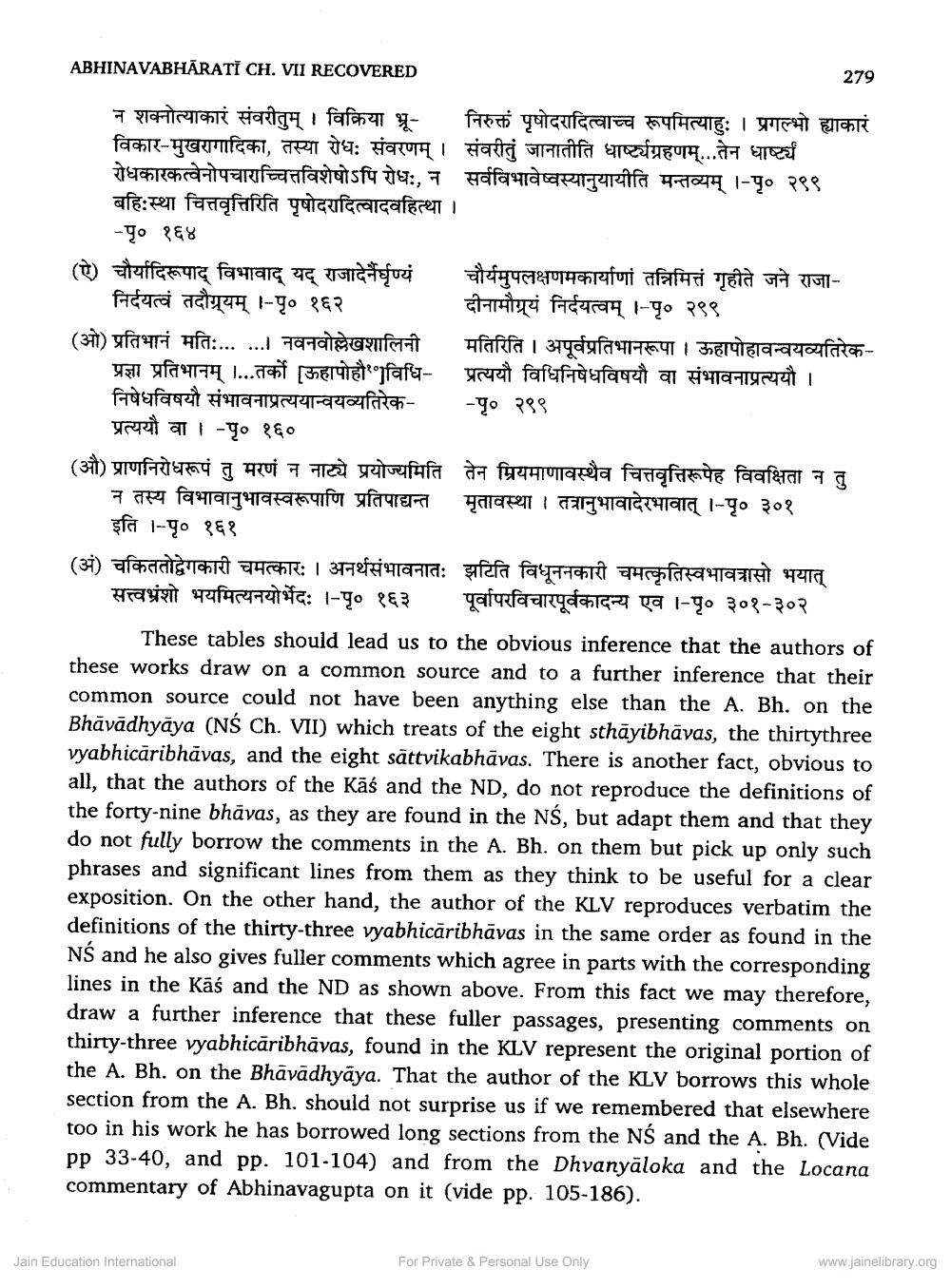________________ ABHINAVABHARATI CH. VII RECOVERED 279 न शक्नोत्याकारं संवरीतुम् / विक्रिया भ्रू- निरुक्तं पृषोदरादित्वाच्च रूपमित्याहुः / प्रगल्भो ह्याकारं विकार-मुखरागादिका, तस्या रोधः संवरणम् / संवरीतुं जानातीति धाट्यग्रहणम्...तेन धाष्ट्य रोधकारकत्वेनोपचाराच्चित्तविशेषोऽपि रोधः, न सर्वविभावेष्वस्यानुयायीति मन्तव्यम् ।-पृ० 299 बहिःस्था चित्तवृत्तिरिति पृषोदरादित्वादवहित्था / -पृ० 164 (ऐ) चौर्यादिरूपाद् विभावाद् यद् राजादे धुण्यं चौर्यमुपलक्षणमकार्याणां तन्निमित्तं गृहीते जने राजानिर्दयत्वं तदौग्र्यम् ।-पृ० 162 दीनामौय्यं निर्दयत्वम् ।-पृ० 299 (ओ) प्रतिभानं मतिः... ... / नवनवोल्लेखशालिनी मतिरिति / अपूर्वप्रतिभानरूपा / ऊहापोहावन्वयव्यतिरेक प्रज्ञा प्रतिभानम् ।...तर्को [ऊहापोहौ"]विधि- प्रत्ययौ विधिनिषेधविषयौ वा संभावनाप्रत्ययौ / निषेधविषयौ संभावनाप्रत्ययान्वयव्यतिरेक- -पृ. 299 प्रत्ययौ वा / -पृ० 160 (औ) प्राणनिरोधरूपं तु मरणं न नाट्ये प्रयोज्यमिति तेन म्रियमाणावस्थैव चित्तवृत्तिरूपेह विवक्षिता न तु न तस्य विभावानुभावस्वरूपाणि प्रतिपाद्यन्त मृतावस्था / तत्रानुभावादेरभावात् ।-पृ० 301 इति ।-पृ० 161 (अं) चकिततोद्वेगकारी चमत्कारः / अनर्थसंभावनातः झटिति विधूननकारी चमत्कृतिस्वभावत्रासो भयात् सत्त्वभ्रंशो भयमित्यनयोर्भेदः ।-पृ० 163 पूर्वापरविचारपूर्वकादन्य एव ।-पृ० 301-302 These tables should lead us to the obvious inference that the authors of these works draw on a common source and to a further inference that their common source could not have been anything else than the A. Bh. on the Bhavadhyaya (NS Ch. VII) which treats of the eight sthayibhavas, the thirtythree vyabhicaribhavas, and the eight sattvikabhavas. There is another fact, obvious to all, that the authors of the Kas and the ND, do not reproduce the definitions of the forty-nine bhavas, as they are found in the NS, but adapt them and that they do not fully borrow the comments in the A. Bh. on them but pick up only such phrases and significant lines from them as they think to be useful for a clear exposition. On the other hand, the author of the KLV reproduces verbatim the definitions of the thirty-three vyabhicaribhavas in the same order as found in the NS and he also gives fuller comments which agree in parts with the corresponding lines in the Kas and the ND as shown above. From this fact we may therefore, draw a further inference that these fuller passages, presenting comments on thirty-three vyabhicaribhavas, found in the KLV represent the original portion of the A. Bh, on the Bhavadhyaya. That the author of the KLV borrows this whole section from the A. Bh. should not surprise us if we remembered that elsewhere too in his work he has borrowed long sections from the NS and the A. Bh. (Vide pp 33-40, and pp. 101-104) and from the Dhvanyaloka and the Locana commentary of Abhinavagupta on it (vide pp. 105-186). Jain Education International For Private & Personal Use Only www.jainelibrary.org




